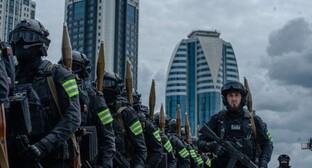04 June 2003, 02:52
Alans
Alans (Alani in Latin), they call themselves irons, in Byzantium sources they are called Alans, in Georgian they are called Os, in Russian - Yas. These are the multiple Iran-speaking tribes that came out of semi-nomadic Sarmat population of the north coast of the Caspian sea in the last century BC. According to the data of Roman and Byzantium writers in the I century AD they settled by the Azov sea and in Transcaucasia, from there they invaded the Crimea and the territory before the Caucasus, Asia Minor and Mydia. Cattle breeding was the base of Alan economy of that time. In the year 372 Alans were defeated by Huns. Part of Alans participated together with Huns in the Great Migration of the Peoples and came to the North Africa via Gaul and Spain. The other part of Alans moved to the foothills of the Caucasus. In the Central district before the Caucasus there formed a union of Alan and local Caucasus tribes headed by Alans and mentioned as Alania in the written sources. There took place the process of settling of nomadic Alans and their transit to economy based on agriculture and cattle-breeding. In the VIII-IX century Alans that temporarily joined the Khazar kaganate started to have feudal relations. At the turn of the IX and the X centuries Alans had an early feudal state; in the X century Alans played an important role in the connections between Khazaria and Byzantium. Christianity penetrated Alania from Byzantium. The development of productive forces and trade caused the appearance of feudal towns. The remains of those are sites of ancient settlements: Nizhne-Arkhuzskoye on the river Bolshoi Zelenchuk, Verkhne- and Nizhne-Judatskiye on the river Terek, Akhalkalinskoye on the river Sunzhe and others.
Famous catacombs burial mounds and sites of ancient settlements on Severny Donets (Saltovo-Mayats culture) and in the north Caucasus illustrate the rich Alan culture. Also common are on-land tombs, and dolmen-shape vaults (in the upper part of Kuban river), on-land stone crypts with false vaults, catacombs that usually consist of a dromos and an ellipse-shaped chamber. Some Alan settlements were protected by the walls made of ashlar slabs with no cement with carved geometrical ornaments, sometimes stylized images of animals and people. The applied art of Alans of the IV-V centuries is presented mainly by the jewelry made of gold and silver with mainly red semi-precious stones or glass (the so-called multi-colored style); later there appeared pendants and other decorations with birds? heads. In the VII-IX centuries there appeared the cast antroph-amorphous images, figures of horsemen, stamped bronze plaques with vegetative and geometrical ornament that decorated the clothes and the horse. Objects from the Zmeisky burial mount (North Ossetia) illustrate the flourishing of the Alans? art in the X-XII centuries: ornamented gilded plates, folding amulets, toilet necessities, clothes, sable sheaths, unique decoration of the horse head in the shape of half-length female figure, fragment of leather horsecloth with embroidered peacocks and network. In the X-XII centuries literacy appeared among Alans, there was created heroic Nart epic story.
Alans were heavily defeated by Mongol-Tatars that finally captured the valleys before the Caucasus in 1238-39. The surviving part of Alans went to the mountains of Central Caucasus and to Transcaucasia (South Ossetia) where they assimilated with local Caucasus population. Since the XIV century Islam started to spread among Alans. Modern Ossetins are direct successors of Alans. Alans played a certain role in the ethnogeny and culture of the other peoples of the North Caucasus.




